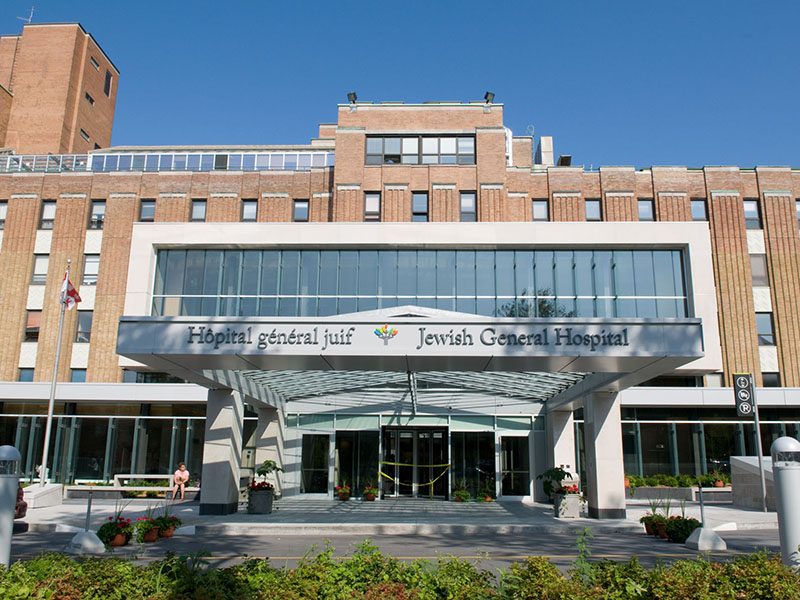When the Jewish General Hospital (JGH) opened in 1934, religious communities were responsible for social welfare and the shortage of hospital beds was dire.
But the founders of the JGH had an additional motivation: employing the growing number of Jewish doctors who were having trouble finding jobs at hospitals, largely due to prejudice.
Despite that, as a new history of the JGH emphasizes, the founders envisioned a hospital that, while providing an environment that would be sensitive to Jewish patients’ cultural needs, would provide care to everyone.

The book, The Sir Mortimer B. Davis Jewish General Hospital, was published for the Jewish General Hospital Foundation by McGill-Queen’s University Press and is co-authored by Frank Myron Guttman and Alexander Wright.
Guttman, a former chief of general pediatric surgery at the Montreal Children’s Hospital, trained at the JGH between 1959 and 1964, and joined its staff a year later. To his knowledge, he was the first Jewish full professor of general surgery at McGill University.
After his retirement in 1996, Guttman went back to university and earned a degree in Quebec history. He picks up from a history of the JGH that was written by Wright, now chief archivist in British Columbia’s public service, for its 50th anniversary in 1984.
In the foreword, Dr. Lawrence Rosenberg, former JGH executive director and now head of the regional body that administers it, writes: “This book, in essence, is not only the story of a great medical institution, the JGH, it is also the story of a great Jewish community.”
Indeed, many regard the hospital as the community’s greatest gift to Quebec.
READ: LIBERAL CANDIDATE LAUNCHES OUTREMONT BYELECTION BID
Guttman has added chapters on Jews and medicine, Jewish hospitals elsewhere, health services in the Jewish community before the JGH, as well as profiles of key figures, including: tobacco magnate and philanthropist Mortimer Davis; Allan Bronfman, a prime mover for a Jewish hospital and the JGH’s first president; and its first executive director, Sam Cohen, who served until 1968.
Guttman maps the JGH’s growth from a 230-bed community hospital to a McGill-affiliated 637-bed institution, whose facilities have undergone enormous expansion over the last three decades.
More important than size, to Guttman’s mind, is the reputation for excellence the JGH has earned – in care, teaching, research and innovation.
“The credit for this success has to be given to the drive of the Jewish community of Montreal,” writes Guttman. “Immediately after each addition, plans began for further expansion.”
Between April 1, 2017 and March 31, 2018, 23,969 patients were admitted and about 84,100 emergency visits were recorded, making the JGH’s ER the busiest in the province.
Over the same period, 3,742 babies were delivered, many of them high-risk births, and 11,263 surgeries were performed.
As of September 2015, the JGH had 697 attending physicians in more than 40 specialties – most of whom taught at the McGill medical school, including department chiefs – and 1,636 nurses. Likewise, over 900 medical residents pass through the hospital annually.
The hospital had 5,142 staff members in total and over 1,000 volunteers, which Guttman claims is the largest corps in any Canadian health-care institution.
The JGH has gained such a stellar reputation that people from around Quebec are treated there. Government funding, however, has not kept up with demand, Guttman notes, leaving the JGH “the victim of its great success.”
Reproduced in the book is a 1929 artwork that sums up the JGH’s mission. It depicts a woman with a headband reading “Humanity,” while holding a sign that reads: “We want to build a hospital that will be a credit to our race and city, and also to prove how much we appreciate what others have done for us. All creeds and races will be welcomed in this hospital.”
It’s interesting to learn that Anglican Canon A.P. Shatford stood beside co-chairs Allan Bronfman and Michael Hirsch at the campaign launch at a massive rally at the Mount Royal Hotel on Sept. 22, 1929.
Impressed with their resolve, Premier Louis-Alexandre Taschereau saw to it that the government contributed $300,000 to the project.
The new hospital was constructed at the north end of Côte des Neiges Road, on what was then mostly farmland.
Guttman profiles the JGH’s executive directors up its last, Lawrence Rosenberg, now president and CEO of CIUSSS West-Central Montreal, and some of its eminent doctors. No modern history of the JGH would be complete without a recognition of fundraiser extraordinaire Sheila Kussner, founder of the pioneering Hope & Cope cancer patient support program, who is rightly included.
Guttman concludes with a plea for more rational government funding: instead of hospital budgets being calculated globally, he thinks they should be based on the volume of activity at each institution over the year.
As one of the busiest hospitals in Quebec, the JGH would benefit from such a system, instead of being “penalized,” he believes.
“In the meantime, the ongoing budget cuts continue to make the delivery of high-quality health care a challenge in this province. Until this method of remuneration is changed, I am afraid that medical care will continue to deteriorate,” he writes.
